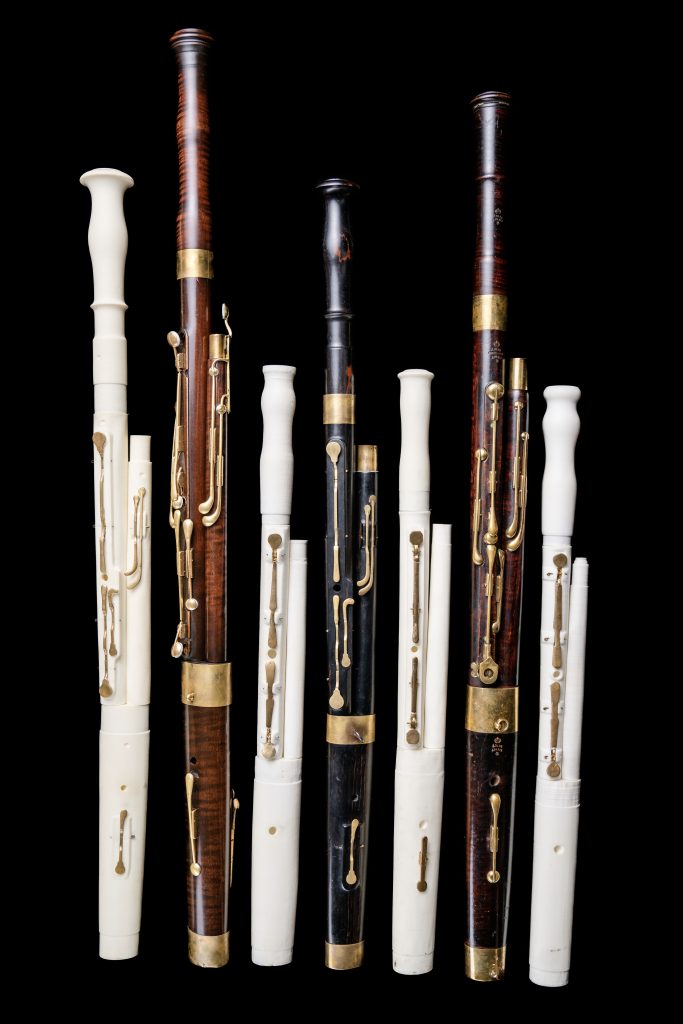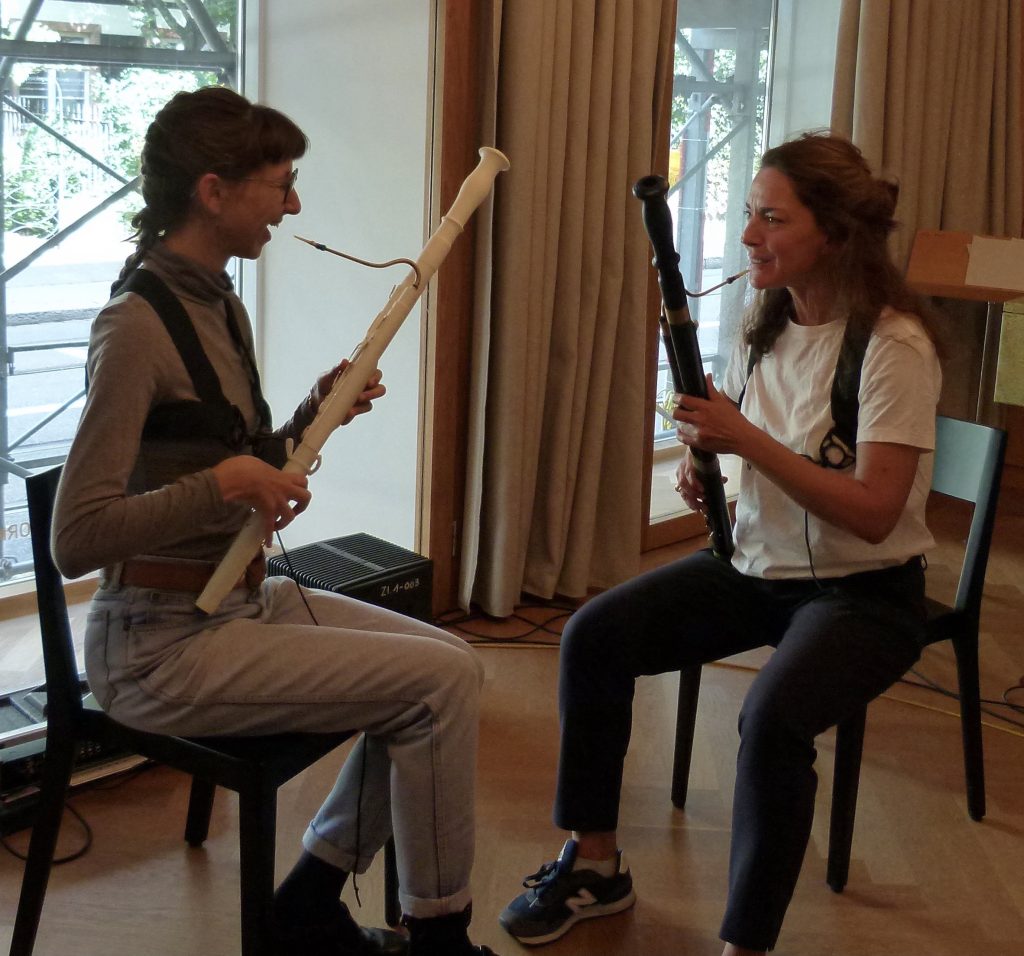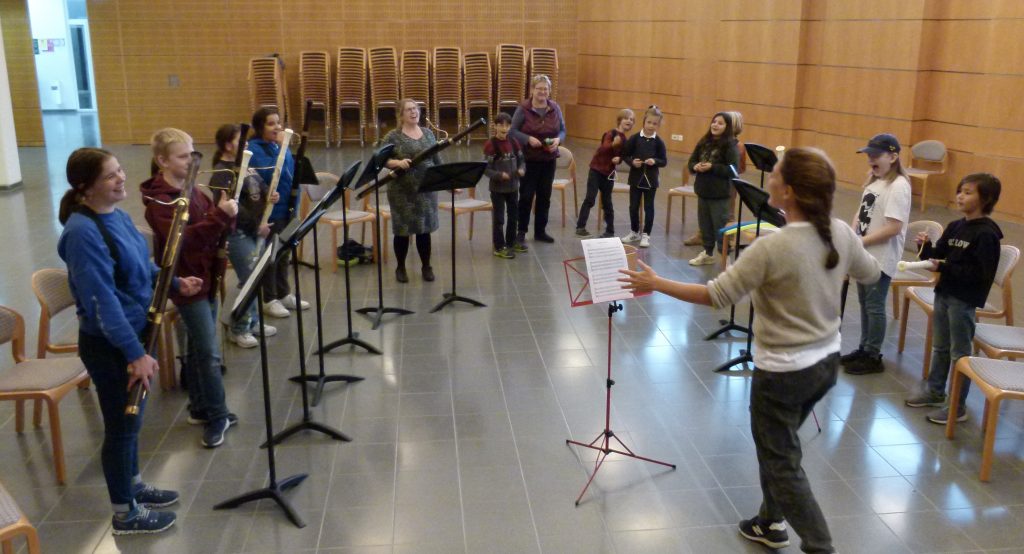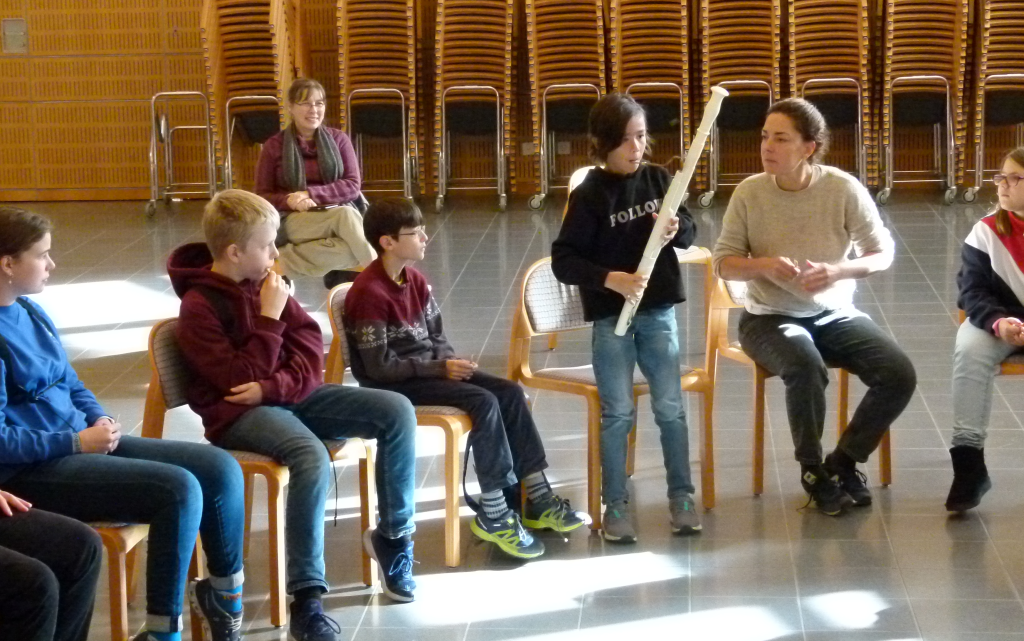Summary: Pedagogy with the historical fagottino

Introduction: The pedagogical use of small-sized historical bassoons is, with few exceptions, a new phenomenon and requires some special forethought. The educational method described here is based mainly on the technical and structural characteristics of our new synthetic instruments, intended for both adults and children. The instruments are lighter, have fewer keys and simple tone holes. They are much more flexible in pitch than their modern counterparts, and therefore require careful ear training monitored by the teacher.
History: Small-sized bassoons, in existance since the instrument’s beginnings, were being used and taught until the First World War, after which they completely disappeared and were apparently not played or taught for decades.
Bassoon pedagogy for children in recent times entailed the building of modern full-sized instruments with special mechanisms for children’s hands. For Guntram Wolf, the goal was instead to adapt the instruments perfectly to the needs of the children, i.e., to build instruments that were small, light, and easy to play. Here he and others achieved great success in the 1990s, especially with the development of the smaller bassoons (or “modern fagottino”, in C, G and F transpositions). The creation of a fagottino tailored precisely to children’s needs, with small dimensions, lightness and mechanical simplicity, led to a big boom in pedagogy. Other manufacturers such as Moosman, Fox, Howarth, and Bassetto also offer modern fagottini especially tailored for children, and thus contribute to a greater variety. This has enabled an early entry into the world of the modern bassoon, giving great impetus to the development of pedagogy in the context of the modern bassoon, but not in the area of historical instruments.
Our reasoning is that what happened in the history of modern bassoon pedagogy (thanks to the “reinvented” fagottino) will similarly happen with our new synthetic instruments, and offer new perspectives and possibilities within the pedagogy of the historical bassoon. Until now, studying the historical bassoon has meant a mandatory transition from studying the modern bassoon. With the creation of our new instruments, it is possible to start playing a five-key historical instrument already from the age of six.
Instruments: The previous lack of a small, child-friendly historical bassoon made it impossible for the youngest to begin directly. Therefore current pedagogy of period bassoon is aimed at young people and adults who, in the vast majority, have studied modern bassoon or other instruments such as the recorder. Small-sized historical bassoons have not yet been used.
Of all the historical tenoroons and fagottini we found and measured (more than a hundred), we chose six for our trials (two in a pre-project experiment, and four for the last SNFS project). Synthetic prototypes were first produced, followed by conventional wooden models. Thanks to these reconstructed instruments, which are smaller and easier to carry and play, it will now be possible to start early instrumental historical bassoon lessons with tenoroons and fagottini.
These instruments, while varying widely in size, bore, intonation, etc., all share a great deal of flexibility in intonation, a flexibility far in excess of that of the modern bassoon or fagottino. This presents a major technical difficulty for a professional adult, let alone a child. This peculiarity which theoretically could represent an obstacle to the ease of playing, is viewed as a peculiarity that changes and enriches the pedagogical method. Use of the small historical instruments therefore calls for a new teaching method for children.
Pedagogy with historical tenoroons and fagottini: We seek a form of holistic pedagogy that shows as many cross-connections between theory and practice as possible. Major themes of modern bassoon pedagogy are air flow and stability of the embouchure (not unsimilar to trumpet or horn) and are usually dealt with gradually and in the first few years. We make a virtue out of necessity and they are tackled immediately.
Due to the simpler mechanics of the historical small-sized bassoons, the focus is mainly on hearing. Listening to the pitches being produced by the teacher and imitating is the first step for beginners. Musical notation should not always be the primary medium; auditory training should be increasingly integrated into the lessons. Some of our primary learning goals are, for example: being able to distinguish pitches, identifying intervals or arranging and playing small rhythmic and melodic motifs.
Notation, both of notes and rhythm, recedes into the background. The method is based more on the practice of listening, improvisation and imitation.
The future: All of us who came to historical bassoon studies via the modern bassoon know that modern pedagogues tend to consider an approach to the historical instrument only possible once all technical basics of the modern instrument have been solidified.
We think that the opposite is possible. Period bassoons can be offered to modern bassoon students right from the start. This makes the work more substantive and perhaps more complex for both the student and the teacher, but it also encourages flexibility and awareness of the characteristics of the different instruments and enables the student to independently find the means to control the different sounds.
Beginning the simultaneous study of modern and historical bassoons at a young age could be compared to children’s bilingualism. It is a well known fact that a child’s ability to perfectly imitate the sounds of a language is much higher than that of an adult and that this diminishes as we grow older. If a child can learn both instruments from an early age, one could call this a kind of musical bilingualism.
The return of the historical tenoroons and bassoons and the pedagogy associated with them will give rise to a new generation of bassoonists: those who have not previously played the modern bassoon or recorder, as has been customary up to now, and have dealt with the characteristics of the historical bassoon from the very beginning.
Summary of two workshops

Workshop 1 – Adults: The first one-day workshop took place in September 2022 at the Schola Cantorum. A prerequisite for participating in the Historical Fagottino Day was fundamental knowledge about the historical bassoon. There were six bassoonists registered for the course, all of whom were already professionals or historical bassoon students.
First the instruments chosen for the workshop were presented: FT42 Savary jeune (11) 11-key tenoroon in F and the FT6 Anonymous (7) 8-key tenoroon in G. We had four models of each at our disposal, two in nylon (with the original and rounded bore) and two in wood, supplied by the manufacturer Vincenzo Onida (a prototype and an original version), as well as the two originals, kindly made available by Christoph Peter and Áurea Domíngues.
Each participant was provided with reeds for both FT6 and FT42 and given the opportunity to try the instruments in short improvisation games. Afterwards, two work groups were formed with five instruments each, coached by Zoë Matthews and Letizia Viola. Simple ensemble music was studied, with attention to intonation and technical matters such as fingerings.
Christoph Peter, a well-known bassoon/fagottino pedagogue in Switzerland, gave an interesting presentation about his teaching concepts and the development of his own pedagogical method.
The work groups changed instrument models and repeated studies together, working on ensembles to be presented at the end of the day. Although there was only a short time for preparation, the small orchestra of bassoons made of different materials and shapes produced an unusual and fascinating sound that inspired everyone in the audience and ourselves.

Workshop 2 – Children: A total of fifteen children, from seven to sixteen, attended this whole-day workshop. The work was similar in structure to the adult workshop, but obviously with different content, using many of the games described below on this page. We divided into three groups, using three models: FT6 Anonymous tenoroon, FT42 Savary tenoroon, and FT30 Scherer fagottino (again with four copies of each instrument).
This was the first encounter with the historical fagottini for most. Besides the difficulties of experimenting and interacting in an unknown group, the new instruments were difficult to control in the beginning.
The greatest issue for the young modern bassoonists lay in the stability of the airflow. Accustomed to the modern bassoon and blowing into a bore lined with a hard natural rubber, they were all amazed by the instrument’s flexibility. We were surprised at how quickly they learned the new fingerings of the period instruments and the flexibility they were able to develop throughout the day, in terms of approach and the way of blowing into the instrument, which fundamentally evolved from the blowing technique required for the modern bassoon.
As soon as they were able to produce sound, an infectious enthusiasm was released. Everyone liked the lightness and small scale of the instruments, and noticed the varieties and beauty of sounds. Notably, they were happy about having fewer keys. The day ended with a lively performance of everyone together.
FORTHCOMING: A Pedagogical Method for Children (link forthcoming)
An overview of contents:
Objectives:
- Instrument description
- Posture of the instrument (with photos)
- Tone production
- Reading musical notation
- Rhythm
- Articulations
- Improvisation
- Fingerings and music notes on the instrument
- Scales, natural notes, and notes up to two sharps and flats
- Music
How to learn:
- Group classes
- Games
- Playing canon and scales
- Improvisation and composition
- Repertoire from historical sources or own arrangements

Games:
“Rhythm 1” / Everyone sits in a circle and taps their feet together in the same rhythm, saying “1, 2, 3, 4.” On 1 and 3, each one touches the hand of the neighbour lightly. On 2 and 4, the everyone claps their hands in front. The soloist in the middle improvises a melody on top of this rhythm.
“Rhythm Orchestra” / Four rhythmical students sit spread out in the room. Student 1: Beats the ground 4/4 measure. Students 2, 3, 4: Beat simple rhythms that fit. All the others beat first the basic rhythm, and eventually try out the other stations.
“Listen and play 1” / All children and teacher(s)sit in a circle. A small object is passed around, simaltaneously a tone is played. The receiver duplicates the tone and passes it further with a new tone, and so on.
“Listen and play 2 – Parrot game” / A student plays a note on the fagottino and the group repeats the same note as quickly as possible. When everyone has given a note to the others, they can go on with more notes and rhythms to be repeated by the rest in the same fashion.
“Tone production 1 – producing musical character” / We imagine certain moods (for example, “angry”, “dreamy”, “happy”). Each student presents a mood with her/his instrument and the others guess which emotion is being portrayed.
“Tone production 2 – Roll the melody” /The group stands in a circle, and one student in the middle has some soft, small balls. She/he rolls a ball gently to another in the circle and this student plays a note. When everyone has played a note, the student in the middle makes a melody or chord out of the collective tones.
“Warm, warmer, cold, colder” / A student leaves the room and the class hides an object. The returning (blindfolded) student searches for the object, while the class reacts with their instruments. The closer she/he is to the object, the louder the group plays. If the student is farther away, the class plays softly and/or very short notes.

Suggested repertoire:
(Forthcoming)